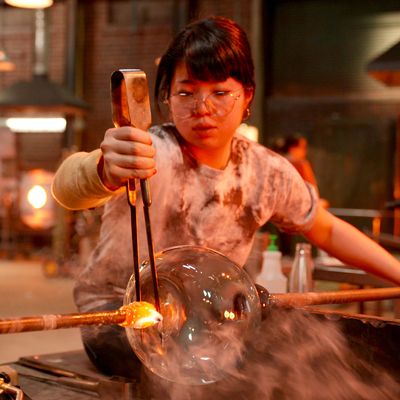
The first season of Blown Away dropped on Netflix in July of 2019. At the time, I characterized it as ideal summer viewing, but I was wrong. Blown Away, whose second season arrives on Netflix today, is a winter show, always has been, and that should have been obvious to me two years ago.
The series is structured like pretty much every other competition show that has ever existed: Ten contestants engage in a different challenge during each episode, with one person getting knocked out in every installment until, in the finale, a champion is named. What’s different is that it focuses on glassblowing, a physically demanding, primal, and tactile endeavor that most people have probably never witnessed, let alone attempted themselves.
Certain aspects of that process make this an inherently winter watch, which is to say it’s the sort of show that will fit seamlessly into whatever hygge routine you have established. Slide on the fuzziest socks, brew the hottest tea, burrow under your favorite blanket, and turn on Blown Away.
For those not previously exposed to the world of punties (the rods used for sculpting glass) and glory holes (that’s what they call the furnaces where glass sculptures are heated — really, it’s not dirty!), there is major ASMR-adjacent action in Blown Away. The things that can be done with glass, especially when it’s hot and malleable, are mesmerizing to watch. Contestants stretch it for several feet like it’s a huge, infinitely flexible piece of bubble gum. They blow — hence the name blown glass — into the punties to expand the bubbles and balloons on the other end. They shape and press what look like huge globs of goo but will eventually harden into sculptures, vases, or perfume bottles. Even though I know it would scald and possibly permanently remove my skin from my body, I kind of want to bathe in a vat of scorching liquid glass when I watch Blown Away?
The artists also often roll their still-in-progress pieces through frits, bits of crumbled, hard glass that adhere to the primary surface the way kosher salt sticks to the rim of a margarita, another extremely tactile, satisfying thing to witness. While the general sensibility of Blown Away emphasizes the pressure that the artists are under to get their work completed in a brief period of time, the camera occasionally pauses to linger, almost lovingly, on some of these more hypnotic steps in the process.
Glassmaking can be soothing, but it’s also an athletic endeavor, pursued in an environment that is sweltering. The show’s set, billed as the “largest hot shop in North America,” is filled with furnaces, torches, and other tools designed to generate sparks and smoke. Sweat drops off the contestants’ noses and runs into their eyes. There’s more perspiring in Blown Away than there sometimes is in the entire first half of an NBA game. And in winter, you love to see that, especially when it’s below freezing outside. Blown Away warms the blood.
The whole point of hygge is that it’s supposed to engender feelings of coziness and contentment, something that does not align with the stress of most reality-competition shows. But Blown Away is fairly gentle in that regard. The primary judge, artist and professor Katherine Gray, is demanding yet super-chill in her demeanor. I believe she could raise her voice if she wanted to — I am just not sure she’s actually ever done it. Really, the most jarring thing that happens on Blown Away is when someone breaks or cracks a piece they are working on with little time left to fix it. Will you gasp when this happens? Probably. But it won’t kill the vibe.
Certainly there are conflicts between some of the contestants, or at least the ginned up suggestion of conflicts. But even those are pretty low-key. If there is a “villain” in the second season of Blown Away, it’s Chris Taylor, the most experienced glassblower in the group and the one who often arrogantly asserts that his artistic vision is much more fully formed than that of his counterparts. “Chris Taylor doesn’t do googly eyes,” he says in episode three, suggesting he won’t sink to the level of sculpting a cartoon character during a challenge that literally asks the competitors to sculpt a cartoon character. Men who think they understand art more than anyone else in the room and are therefore superior make me break out in rage-hives. But Chris later reveals some things about himself that show a more vulnerable side. Even the most blatantly hateable person on Blown Away can’t really be hated.
This should probably be obvious considering that this is a glassblowing show that calls itself Blown Away, but every episode is rife with extremely corny puns. “Is this gallery lit?” asks host Nick Uhas right before he and the judges begin to assess pieces that are supposed to conjure flames. “I just hope it isn’t a dumpster fire,” adds guest judge Deborah Czeresko, season one’s champion. Dad jokes are celebrated on this show almost as much as glass artistry is.
Blown Away is a Canadian production, and that explains a lot about its affable pleasantness. Even when glass does break on this show, it’s usually okay. No one bleeds. A piece can usually be salvaged. And when you’re watching while in quarantine, the best part of seeing a mess of shards on the floor is knowing you don’t have to move a muscle. Someone else is going to clean it all up.


